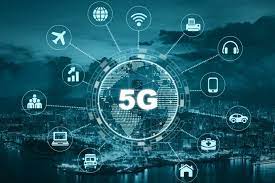What is 5G?:
The fifth-generation (5G) technological standard for broadband cellular networks, which cellular phone providers started rolling out globally in 2019. It is the anticipated replacement for the 4G networks that connect most modern cell phones. To connect practically everyone and everything, including machines, objects, and gadgets, 5G Tech enables a new type of network. 5G wireless technology aims to provide more users with faster multi-Gbps peak data rates, extremely low latency, enhanced reliability, vast network capacity, and a more consistent user experience. Greater productivity and efficiency enable new user experiences and link new industries.
FastMR Brief:
- According to the GSM Association’s 2020 forecast, one of the most significant industries that would benefit is gaming, which is expected to generate more than $1 billion in income this year. Gaming should be frictionless with 5G technology, allowing players to play on any device with minimal latency difficulties. By 2025, 5G networks are expected to have over 1.7 billion subscribers worldwide.
- The Global Mobile Suppliers Association published the first database in the sector tracking 5G device releases globally in March 2019. The GSA listed 23 companies who had confirmed the availability of 33 various 5G devices, including regional versions, from the upcoming wave of 5G equipment. Many smartphone manufacturers such as Apple, Samsung, and Google support 5G.
- The C-V2X communication technology, first used in 4G, has been promoted by the 5G Automotive Association. It enables communication between infrastructures and automobiles. For instance, in an interview with Ericsson, Jörg Burzer, Member of the Divisional Board of Management of Mercedes-Benz Cars, Production and Supply Chain, said: “With the installation of a local 5G network, the networking of all production systems and machines in the Mercedes-Benz Cars factories will become even smarter and more efficient in the future. 5G Tech opens up completely new production opportunities.”
- According to Gartner industry research, by 2023, the automotive sector will be the most significant market opportunity for 5G IoT solutions, accounting for more than half of the total 5G IoT market and representing 53% of the total 5G IoT endpoint market. 5G will propel the connected car market and address critical road safety concerns, ushering in the next generation of smart vehicles. The share of actively connected cars to a 5G service will rise from 15% in 2020 to 74% in 2023, reaching 94% in 2028.
- IoT Analytics predicted that 5G technology would allow an increase in IoT device numbers from 7 billion in 2018 to 21.5 billion by 2025. It can significantly boost the attack surface for these devices and the capacity for DDoS attacks, crypto-jacking, and other cyberattacks.

5G Tech Insights:
Network slicing will help the 5G tech market to grow exponentially with its specialized use-case scenario. Network slicing divides a single network link into multiple virtual connections using network virtualization. It delivers various resource volumes to several types of traffic. They work with mobile network operators and telecom suppliers to provide pieces of their networks for particular customer use cases, including the Internet of Things factory, smart home, smart energy grid, and connected cars, among others. Network slicing is a tool for the provider to address the different requirements of the enterprises. According to the 2018 GSMA Intelligence IoT Enterprise Survey, 49 percent of enterprises believe network slicing will accelerate 5G deployment for IoT applications. Therefore, network slicing’s capabilities are likely to drive the market forward.
5G architecture can provide tailored infrastructure for IoT applications, increasing industry efficiency. Industry 4.0 relies entirely on robotics and motion-enabled robots to improve plant efficiency. The adoption of 5G will enable IoT-connected devices to use a dedicated network line with a high wireless data transfer that provides real-time data. It generally requires an efficient communication infrastructure and reliable connections with low latency. According to the Alliance for the Internet of Things Innovation (AIOTI) report, the internet of things is predicted to connect 50 billion devices by 2020.
The internet of things, connected cars, virtual and augmented reality, artificial intelligence, and other new technologies require a quick and effective communication infrastructure. Hardware manufacturers are concentrating on producing 5G-enabled gadgets in light of 5 G’s possibilities. ZTE Corporation, for example, is set to release its first 5G phone, the ZTE Axon 20 5G, in September 2020. The Middle East, the Nordic nations, and China are among the regions where the corporation plans to market its phone.
An increase in infrastructure investments for smart cities is anticipated to offer a significant opportunity for widespread deployment of 5G technologies, aiding in the 5G technology market. According to an Accenture report, smart-city solutions employed to manage traffic movement and electrical grids can significantly reduce energy usage, traffic congestion, and fuel costs, potentially saving up to $160 billion.
The main barrier to the worldwide market growth for 5G services is the high cost of installing a 5G network. The required throughput density, base station density, and periodic interest rate pricing affect the prices of 5G infrastructure. Minimizing these costs is essential for effective and high-density small cell installations. Network connectivity necessitates substantial investment as well. IDC predicts that by 2021, spending on smart city technology will surpass $135 billion.
The rapid implementation of 5G technology intensifies the possibility of cyber security threats, which is an alarming concern. Unlike traditional technologies, 5G provides a direct connection to the cellular network, raising the potential of a direct attack. Cyber-attacks will become more common as connected devices and machines recur. As of early 2019, several countries, including the United States, Australia, and the United Kingdom, had taken steps to restrict or eliminate the use of Chinese equipment in their respective 5G networks due to concerns about potential espionage by users of Chinese equipment vendors.
















